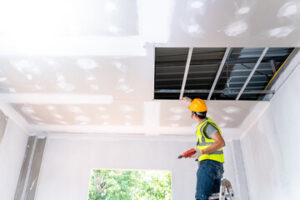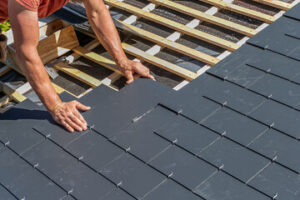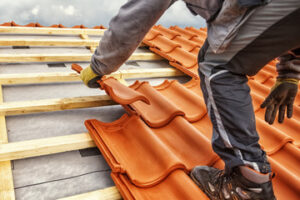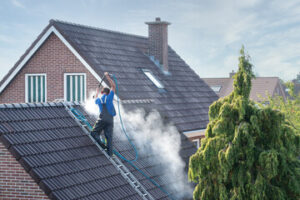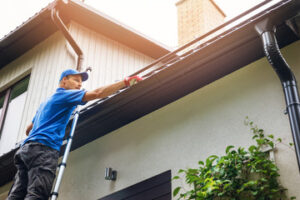Roofing is the first line of defense for a building, protecting it from rain, snow, sunlight and wind. It also enhances energy efficiency and curb appeal.

A well-constructed roof is vital to a building’s structure, but it requires maintenance and repairs to maintain its integrity. When choosing a contractor, ensure they prioritize safety and are licensed and insured.
Plywood is a popular choice for roof sheathing, the material that covers rafters and supports shingles. It is resistant to moisture and offers good strength and stability. It is also less costly than other roofing materials and available in different thicknesses. However, the lifespan of plywood can be limited if it is not properly maintained and regularly inspected.
Oriented strand board, or OSB, is another popular sheathing option for builders. It is made by pressing and gluing wood chips, sawdust, or small pieces of lumber together to create solid boards. The resulting product is stronger and more durable than traditional wood boards, yet still relatively affordable when compared to CDX plywood.
While both OSB and plywood are excellent choices for roof sheathing, the decision of which to use depends on the climate of your area and how much weight the sheathing needs to support. For instance, in regions that are prone to severe weather conditions, roofs require materials that are highly impact resistant. Plywood offers superior impact resistance and is a better choice for these regions than OSB.
It’s also important to note that not all plywood is created equal. While it is easy to find inexpensive plywood, when purchasing sheets for your roof sheathing you should always look for exterior grade plywood that has five separate layers of laminations, or plies. This is what gives plywood its high quality and durability.
The type of plywood used for a roof will depend on the size and weight of the roof as well as the rafter spacing between each truss. Generally, a 1/2″ thickness of plywood is appropriate for most conventional shingle roofs. For roofs with a heavier load, a thicker thickness may be recommended.
Both oriented strand board and CDX plywood are suitable for roof sheathing, but you should keep in mind that both products will need to be treated with waterproof sealants or covered with a protective layer when exposed to the elements. CDX plywood is more resistant to water than OSB, but will swell when wet and doesn’t hold nails or screws as well.
Shingles
Shingle roofing is a popular choice for homeowners who want to add beauty and character to their home. There are many different types of shingles available, so you can find the style that best complements your home’s architecture and personal taste. Depending on the material, shingle roofs can also provide a number of benefits, including insulation and energy efficiency.
Asphalt shingles are one of the most common types of shingle roofs. These shingles are made of a durable and water-resistant material that can withstand various weather conditions, including heavy rain and strong winds. In addition, shingle roofs are usually treated with special coatings that help to enhance their durability and resistance to algae and mold.
Laminated shingles are another type of shingle roof. These shingles are also known as architectural shingles, and they feature a multilayer design that provides a more detailed aesthetic for your roof. Laminated shingles are thicker than three-tab shingles and offer increased protection from the elements, including high winds. They also come in a variety of colors and textures, so you can find the perfect match for your home’s style.
Wooden shingles are another popular option for shingle roofing. These shingles are often made of cypress, redwood, or Western red cedar, and they can be cut in a variety of ways, including hand splitting, quarter-sawing, and plain-sawing. The shingles are then kiln-dried, which helps to prevent warping and improve the moisture resistance of the wood. Depending on the type of wood used, shingles may be either entirely heartwood, which is decay resistant, or mixed with sapwood, which is less decay-resistant.
Another advantage of shingle roofs is their ability to resist damage from hail. Hail impact can cause breaks in a roof’s materials, which compromises its waterproofing capabilities and can lead to leaks and other roofing problems. Many shingle manufacturers now include impact-resistant technology in their roofing products, which helps to increase the durability of these roofing materials.
Finally, shingle roofs are easy to install and maintain. They can be installed quickly and easily by a professional, and they typically do not require much maintenance beyond regular inspections and simple touch-ups. Some shingle roofs are also designed to be solar-friendly, which can help reduce your electric bills.
Metal
Metal roofs have long been associated with commercial buildings, but they are also popular with residential roofing customers. They are durable, energy efficient and attractive, making them a good choice for many different types of homes. When selecting a metal roof, it is important to consider your unique climate, aesthetic preferences and installation options.
A metal roof lasts for 50-plus years, far longer than asphalt shingles and is 100% recyclable at the end of its life. It also offers great design flexibility, with a wide variety of panel profile and color combinations available. Quality metal roofing coatings also resist moss and fungus, reducing the need for harsh chemical treatments that can harm the environment.
Most metal roofing is made from galvanized or weathering steel, with aluminum and zinc alloys added for additional strength and corrosion protection. The best value option is called galvalume, which combines the most desirable features of these three high-performing metals.
One of the most popular reasons for choosing a metal roof is that it can save you money on your energy bills. Its reflective surface helps keep your home cooler in the summer and it reflects sunlight, which also reduces heat gain during the winter.
Another advantage is that it holds snow very well and sheds rain quickly, which makes it a great choice for cold regions. Its fire resistance is a major selling point as well, particularly in wildfire-prone areas.
A common disadvantage of a metal roof is that it may attract lightning, which can cause damage and even set the house on fire. However, this risk is reduced because the roof does not melt and burn as easily as asphalt shingles.
Another disadvantage of a metal roof is that it expands when exposed to heat, which can stress fasteners and seams. This can lead to leaks and other problems. It is important to use concealed fasteners when installing a metal roof. Otherwise, the water may leak into the attic and insulation and corrode the frames and drywall, which can be costly to repair. If you are considering a metal roof, it is best to consult with a professional installer who has experience with these products.
Flat Roofs
A flat roof has a minimal or nonexistent slope and is typically found in commercial or industrial buildings. Unlike slanted or pitched roofs that are found in residential structures, flat roofs require a different roofing system that is capable of standing up to the elements. There are many different materials that can be used for flat roofs, including EPDM, a synthetic rubber membrane that is highly durable and resistant to weathering.
In addition to the materials that are chosen, it is important to consider the geography, cost and purpose of the roof when choosing a roofing system for a flat roof. A good roofing contractor will be able to assist you in making the best choice for your specific needs.
Flat roofs are becoming increasingly popular for use in modern homes and building design. They are a great alternative to slanted roofs because they provide more usable space for outdoor living and can be designed to incorporate features such as green roofs, solar panels, reflective roof coatings (which can reduce heat absorption) and more.
Another advantage of a flat roof is that it is easier to access for repairs and maintenance than a traditional slanted roof. This allows for the inspection and repair of any problems that may arise. Some common issues that can be easily prevented with regular maintenance and upkeep include water pooling and leaks, which can be caused by poor drainage or damage to the roofing system.
It is also important to note that because there is a minimal or no slope on a flat roof, it is more susceptible to damage from high winds than a slanted roof. It is therefore critical to choose a material that can withstand these conditions and to install the roof with proper reinforcement and support.
It is also important to remember that a flat roof will require more frequent maintenance than a slanted roof because it is not as easy for rainwater and snow to flow off of it. If the accumulated water is allowed to build up, it can cause leaks and even structural damage to the roof itself. This is why it is so important to make sure that the roof is properly maintained and regularly inspected by a qualified professional.


